
Planet of Giants sees the Tardis crew shrunk to roughly the size of an inch as they become embroiled in a sinister plot involving a lethal insecticide that could do far worse than just kill pests.
This is one of the earlier DW serials that feels very ambitious considering the scope of the budget and studio space the production team had to work with at the time. The plotting by the normal-sized humans is watchable enough but it’s the escapades with the Tardis crew miniaturised that gives the story its spark.
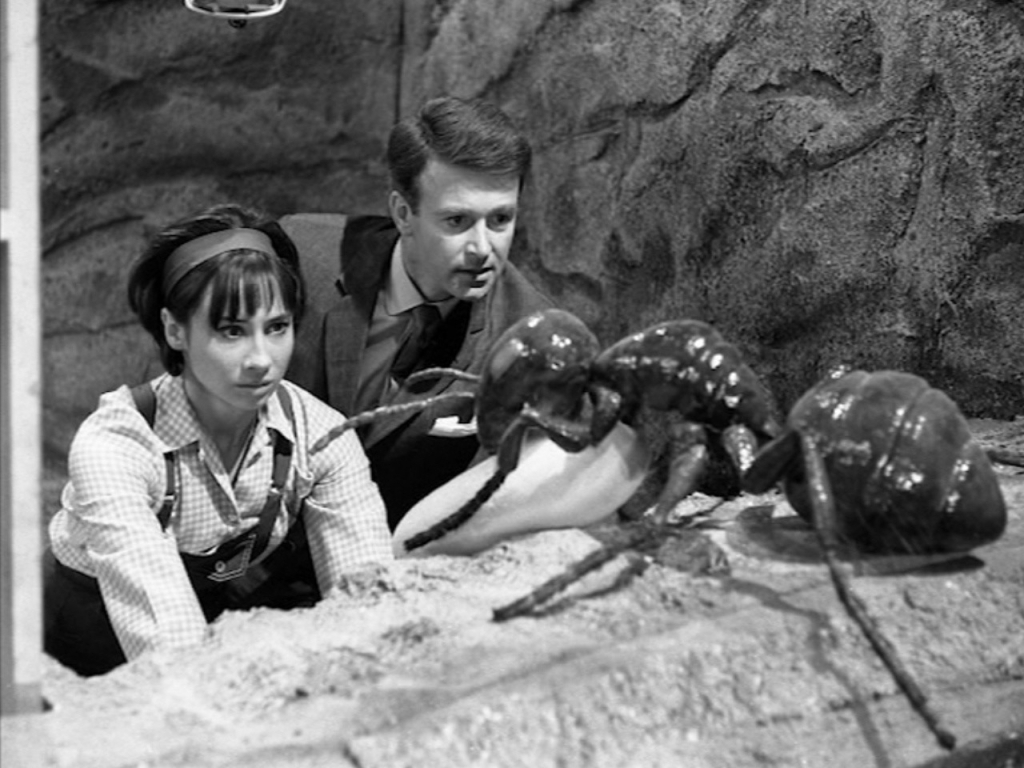
Interestingly, this story was edited down from an intended four parts into three to make it a more spritely season-opener. I can understand why as even with three episodes the serial can be on the slower side but the sets and props of the miniaturised garden and the Tardis crew’s chemistry makes it worth a watch.
3/5

The Dalek Invasion of Earth
From one ambitious story to another, this serial sees the Doctor and company return to earth, albeit in the year 2164, to find that the planet has been conquered by the Daleks and their enslaved humans known as the Robomen. Their plan is to hollow out the Earth to use it as a giant spaceship to conquer other worlds, having almost entirely wiped out the human race with viruses to dwindle their numbers.

The crew quickly get caught up in the invasion with Susan and Barbara (Jacqueline Hill) becoming part of a resistance group who claim to have developed a bomb that will defeat a Dalek, whilst The Doctor and Ian are taken by the Robomen to a central Dalek saucer landed nearby, and try to break out of captivity alongside a fellow prisoner.
From there, the story sees some gripping tension as Barbara must aid resistance fighters Jenny (Ann Davies) and leader scientist Dortmun (Alan Judd) rush across central London to escape the Dalek’s in one of the most iconic sequences of 60s Who. What follows here is also chilling as Dortmun, a paraplegic, confronts several Daleks, foregoing his chair and cane to try and utilise his bomb whilst giving the others a chance to escape.

The eventual uprising against the Daleks also makes for a satisfying climax, albeit one that feels a tad rushed, but the highlight of the story comes with the Doctor’s farewell speech to his granddaughter Susan, who falls in love with resistance fighter David (Peter Fraser) and is therefore left on Earth to forge her own future.
It’s a superb piece of acting from Hartnell and was later used to include the late actor in the 20th Anniversary special The Five Doctors, as a means to open the special.

Overall, TDIOE is a standout piece of early Doctor Who, and though the Dalek voices and Robomen can feel a bit silly at times, as does the Slyther, a creature that disappears as quickly as it appears following a cliffhanger. With that said, the Daleks still possess a suitable menace and the supporting cast works nicely as well.
4/5

The Rescue
This is the shortest story of the season at just two episodes, and serves mainly to introduce new companion Vicki (Maureen O’Brien), an orphan who is marooned on the planet Dido with Bennett (Ray Barrett) and is often terrorised by an apparent native of the planet Koquillion.

The Tardis crew gradually discover, however, that Koquillion is no other than Bennett in disguise, using the front to cover his tracks having murdered a crew member and Vicki’s father, which caused the crash. Along the way, Barbara kills Vicki’s pet Sand Beast Sandy, though this is rather brushed off.

The story’s emphasis on The Doctor feeling the loss of Susan and the steady direction of Christopher Barry make for an entertaining two-parter, which sets up the new Tardis crew dynamic nicely and the design of Koquillion is a definite highlight – even him being a bloke in a suit is rather self-aware for the series.
3.5/5

The Romans
The Romans is the serial in Doctor Who to take a more comedic approach to its proceedings, as the Tardis crew crash land in Ancient Rome and end up spending a month there, relaxing and taking in the sights before getting swept up in the slave trade and the events leading up to Nero (Derek Francis) burning down Rome.
The Doctor and Vicki, having taken a trip to Rome, happen upon the dead body of Nero’s Lyre player Maximus Pettulian and end up being sent here in his place, with the Doctor reluctantly taking up his identity.

In the process, a conspiracy is uncovered in Nero’s midst, and Barbara becomes handmaiden to the Empress Poppaea Sabina, only for the bumbling and farcical Nero to try chasing her down. It is here that the core of the comedy comes into play as Francis plays the character firmly like an overgrown child, albeit with more perverse habits.
The Doctor spends much of the time also trying to locate Nero to try and butter him up, in an attempt to compensate for not being able to play the harp at all – leading to a humorous conclusion for this subplot.

What makes the story entertaining for me most of all is how the characters eventually reunite thanks to a set of events, with Ian forced to fight to the death as a slave whilst Barbara is powerless to stop this, with the event having been caused thanks to the Doctor embarrassing Nero.
The final episode is a prime example of how the Doctor is shown to interfere with Earth’s history, as he accidentally sets fire to Nero’s plans for a new Rome, hereby inspiring him to burn it all down, causing the Great Fire of Rome. Though the historical accuracy is up for debate, it’s an intriguing early example of the concept which would be familiarised again during the Visitation with the Great Fire of London.

Overall, The Romans is a gem of a historical, and is sadly one of only two historical stories that is complete, as much of the other Hartnell historical’s either have episodes missing or are missing in their entirety.
It’s well directed by Christopher Barry as well, who gives the story a more sprightly feel than other stories this season, utilising the effective sets, whilst Dennis Spooner balances out the comedy and drama quite well with his script.
4/5

The Web Planet
Overambitious is the best way to describe The Web Planet, a serial that went over budget due to overtime and proved too costly for the BBC to attempt again at such a scale. As is, the story is often seen in two ways: very dull or very entertaining, albeit in an almost b-movie quality.

The key iconography from the story is the insect like creatures that inhabit the planet Vortis. These are the Zarbi, Optera and Menoptra, the former being ant-like beings that communicate entirely in chirps, whilst the latter races are moth and grub-like beings that are related as descendants and forge an alliance with the Tardis crew to take on a malignant being that is controlling the Zarbi known as the Animus (Catherine Fleming).
Whilst the Menoptra costumes are quite reasonable for humanoid moths, the Zarbi are very much blokes with an ants body shoved on top of them, and whilst it’s commendable that the actors do their best with what must have been minimal sight, they are very clumsy and it’s clear that the sets were too tight for the suits (leading to one occurrence of an actor bumping into the camera). As for Optera, they hop around in quite a humorous fashion, which I can’t help but chuckle at.
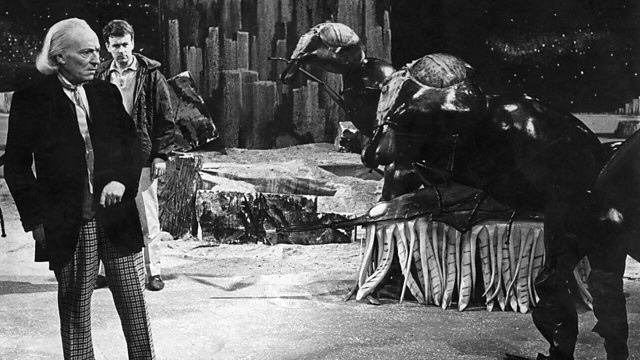
The Animus makes for a convincing being though, communicating through a tube lowered from the ceiling and making for an intriguing antagonist to overcome. The script from Bill Strutton provides the Tardis crew with some good material though, and with a bigger budget this could have been quite the epic.
Richard Martin as a director here also seems to struggle with the scale of the project, but it’s hard to imagine anyone in the position ably guiding the story. Curiously, the episodes also have this blurry effect to them, which according to the documentary was due to the recording being done for some scenes Vaseline smeared in to create a more blurred effect.

Overall, The Web Planet is a sympathetic but over-ambitious story that earns its reputation as both amiable but also at times easy to poke fun at, especially when the story tries for action sequences with numerous monsters onscreen. I rather liked it though, despite its shortcomings.
3/5

The Crusade
In contrast to The Romans, The Crusade is played firmly straight as a historical, taking place during the 12th Century in Palestine during the Third Crusade and the ongoing conflicts between Richard the Lionheart (Julian Glover) and Saladin (Bernard Kay).
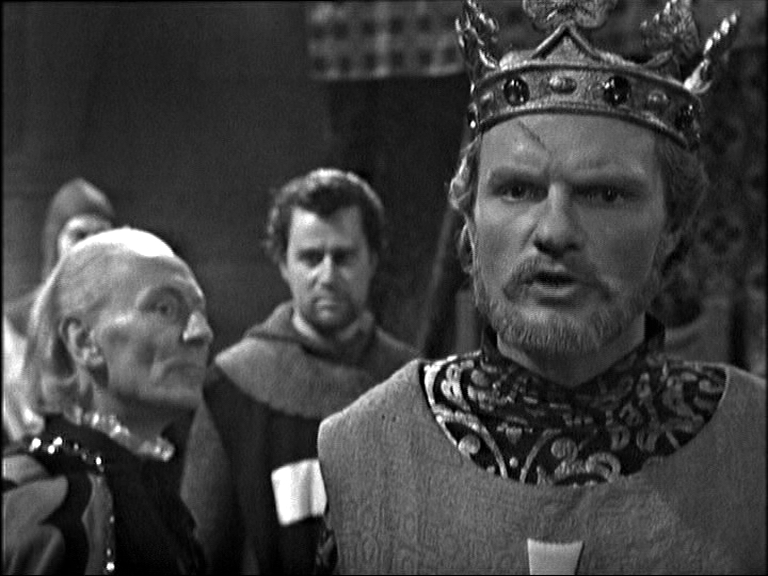
David Whittaker’s script sees Barbara kidnapped (again) by the Saladin, being mistaken for Lady Joanna alongside William des Preaux (John Flint) as Kind Richard, in a deliberate rouse to keep the King safe. Meanwhile, the Doctor, Ian and Vicki end up in King Richard’s court, with Vicki masquerading as a male “Victor” and Ian being knighted as Sir Ian to serve as an emissary to Saladin’s court, all in an attempt to save Barbara whilst trying to forge a truce.
As the only serial this season with episodes missing, I was quite impressed with how the missing episodes held up alongside the two that existed, and though some plot elements felt very familiar here, the guest cast are on great form, especially Jean Marsh as Lady Joanna and Julian Glover as Kind Richard, who would appear again in 1979’s City of Death, and the subtext of a closer relationship between them despite their status as siblings.

A problematic element for the serial though is the use of black face to portray Saladin, El Akir (Walter Randall), Seraphin (Roger Avon) and his men. Asides from this though I found the serial to be one of the highlights of the season, and it was great having a high quality reconstruction of the missing episodes to fill in the gaps.
4/5

The Space Museum
The Space Museum has a great first Episode full of mystery, as the crew explore a museum on the Planet Xeros and find that they will become exhibits if they cannot change their fate. The story evolves to become a clash between the Moroks who own and run the museum, and the planet natives, the Xeron’s, who have become subservient to them.

If the latter storyline sounds a generic in concept, then it’ll be even more dull in execution. The remaining three episodes of this story are rather banal, despite the cast trying to elevate proceedings and one memorable moment wherein the Doctor hides inside the casing of an empty Dalek on display. This story is often considered one of the weakest of Hartnell’s run, and I am hard-pressed to find a story that is weaker overall, despite the engaging first episode.
1.5/5

The Chase
The second Dalek serial of the season sees the Daleks chasing the Tardis crew through time and space with their own Time Machine, in an attempt to commandeer the Tardis for universal domination.
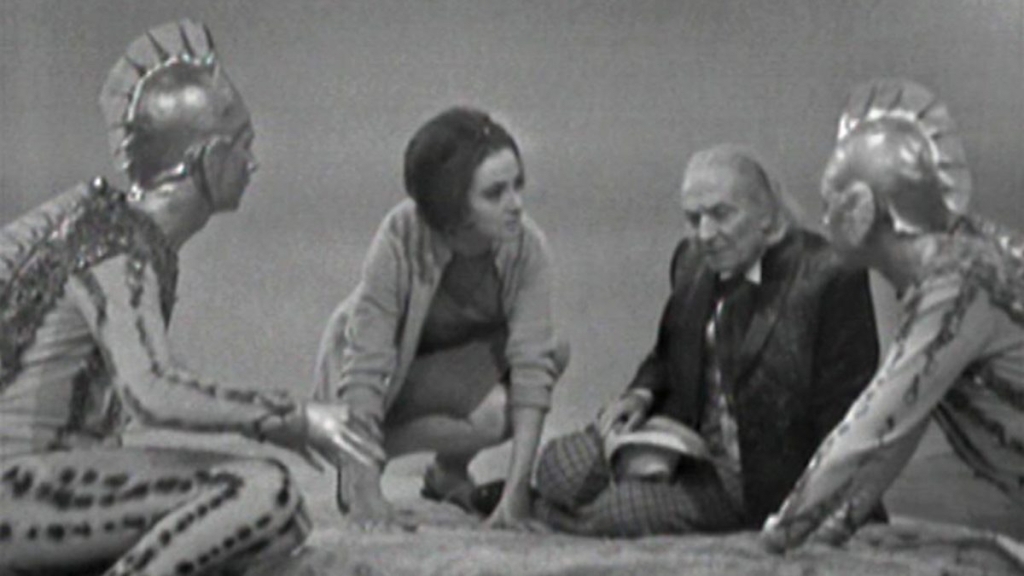
The journey takes the crew to various planets like the desert landscape of Aridius, the Empire State Building in the 1960s, aboard the Mary Celeste and even a mysterious haunted house before ending up as prisoners of the Mechonoids, spherical robots that have also imprisoned astronaut Steven Taylor (Peter Purves) who eventually joins the crew in the following serial.
The story is also notable for the departure of Ian and Barbara, resulting in all of the original companions departing the series by the end of Season 2, which was a shock for viewers and especially for lead actor William Hartnell.
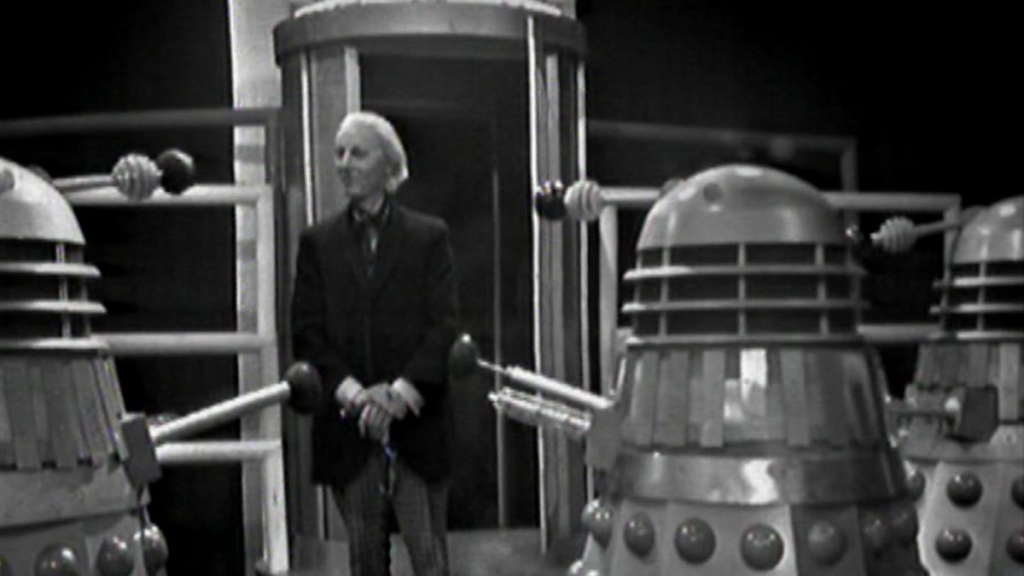
Not dissimilar to The Web Planet, this is another very ambitious storyline, and like that serial also comes with its drawbacks, though in this case it comes from an attempt to make the Daleks more comedic – like having one that struggles to count or one that drives itself into the sea. The Dalek voices are a noticeable improvement over TDIOE though.
There’s also some peculiar segments like Dracula and Frankenstein’s Monster (or actors playing them) destroying a Dalek, or Peter Purves’ double-role as a tourist at the Empire State Building, chatting a Dalek’s ear off and somehow not getting exterminated in the process. The most significant though, certainly from a historical perspective, is a scene in the first episode where the crew end up watching a portion of The Beatles performing “Ticket to Ride” on the Time-Space Visualiser (a memento from the Space Museum in the previous serial) which is the only known clip of this performance to survive.

I rather like The Chase, but for me it’s the weakest Dalek story of the 1960s, and feels inconsistent and a bit unfocused at times. The Mechonoids are great but only appear towards the final act, but we do get a superb action sequence putting them against the Daleks which is worth watching the serial for alone.
3/5

The Time Meddler
This serial marks a few notable firsts, including the first appearance of another Time Lord and the idea of meddling with time in such a way as bringing technology from the future to the past, making for a great cliffhanger to episode one.

It also introduces Steven as a companion, who in his initial story is sceptical and sardonic about the Tardis and its capabilities. Writer Dennis Spooner really gets his teeth into the new dynamic here, in such a way that other writers sadly didn’t utilise, as Steven often got shorted as a companion.
The most memorable part of the story is Peter Butterworth’s Meddling Monk, a Time Lord masquerading as a Monk in 1066 England, who schemes to alter history by wiping out the Viking fleet of King Harald Hardrada and thus allowing Harold Godwinson and his Saxon soldiers to defeat William of Normandy and his Norman soldiers during the Battle of Hastings.
He makes a perfect foil for the Doctor, riling him up and making for a worthy antagonist. He gets a good comeuppance at the end of the story, but would make a reappearance in The Dalek’s Masterplan, of which Dennis Spooner would write half the episodes for.

This is a great story to end the season on, and is my personal favourite of the season, trying new ideas that stick nicely and also delivering a new dynamic to the Tardis crew that it really needed.
4/5

Overall:
Best Story: The Time Meddler
Worst Story: The Space Museum
Must see: The Dalek Invasion of Earth, The Romans
Check out Part Two of our review, where we unbox the set and look through the video & audio quality, and discuss the special features.
By HW Reynolds
Images courtesy of the BBC
Source link
